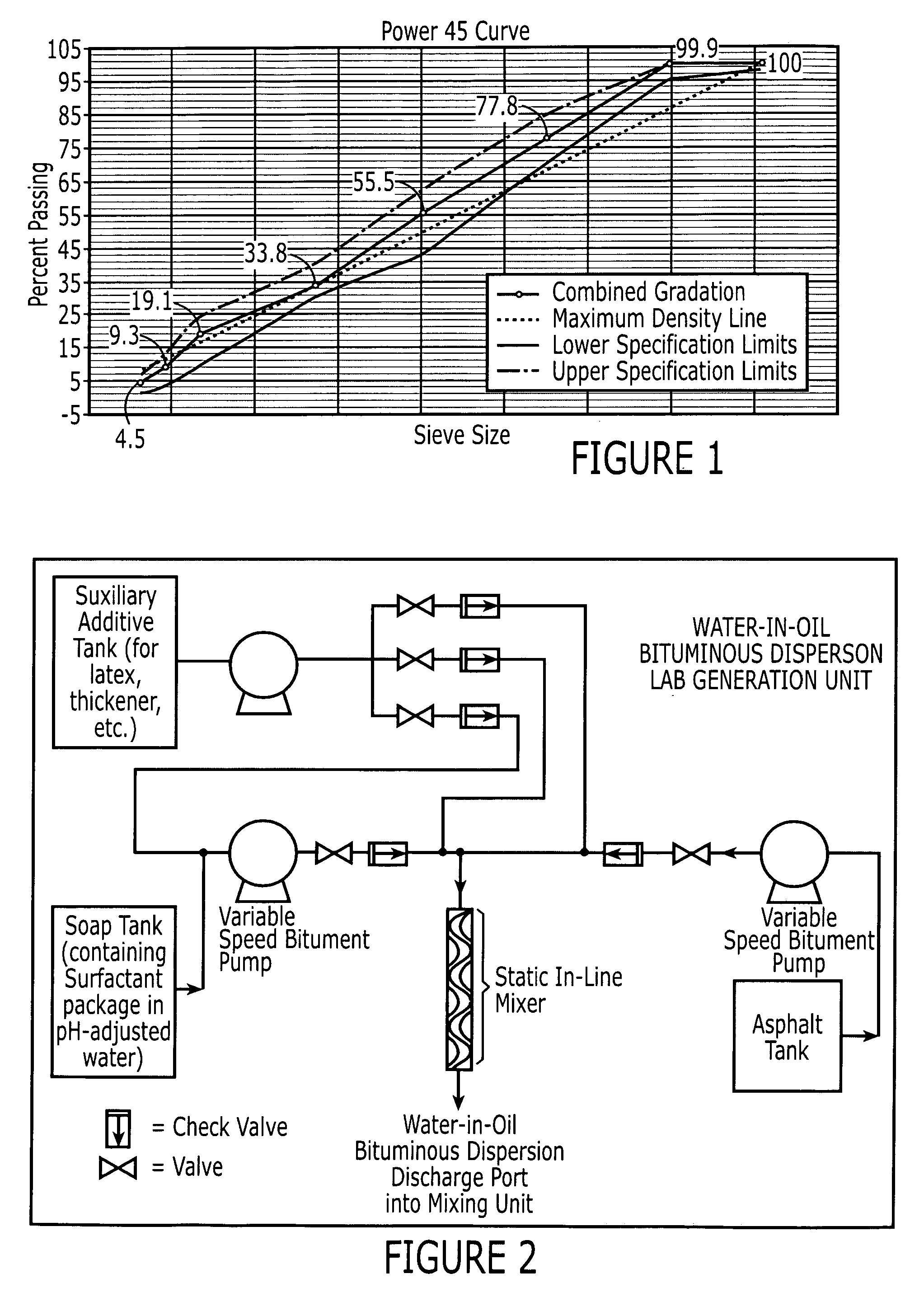Water-in-oil bituminous dispersions and methods for producing paving compositions from the same
a technology of bitumen dispersions and water in oil, applied in the field of waterinoil bitumen dispersions, can solve the problems of reducing the early compressive strength of compacted pavement, paving compositions typically exceeding 290° f, and invert emulsions are not created, so as to achieve low interfacial viscosity, high interfacial bitumen solubility, and low marangoni
- Summary
- Abstract
- Description
- Claims
- Application Information
AI Technical Summary
Benefits of technology
Problems solved by technology
Method used
Image
Examples
example 1
[0064] The asphalt used was performance-graded asphalt, PG67-22. Other viscosity-graded, penetration-graded, and performance-graded asphalts are suitable for this type of invert emulsion production. The aggregate used was dense-graded aggregate complying with Superpave aggregate qualities and performance specifications.
[0065] Bituminous compositions were prepared by the following procedure. To 15 parts water containing alkyl polyamine surfactant at pH 2.5 and a temperature of 85C. was added 85 parts PG 64-22 bitumen heated to 135C. The bitumen was added slowly so that the temperature of the resulting invert water-in-bitumen dispersion was maintained below 100C. Roughly 70 parts of the above invert water-in-bitumen dispersion were immediately added to roughly 1000 parts dense-graded granite aggregate conforming to gradation and property specifications for ½-inch nominal wearing course paving aggregate and heated to 120C. The composition was mixed 60 seconds to produce bituminous com...
examples 2-4
[0068] The asphalt used in Examples 2-4 was performance-graded asphalt, PG67-22. Other viscosity-graded, penetration-graded, and performance-graded asphalts are suitable for this type of invert emulsion production. The aggregate used in Examples 2-4 was dense-graded aggregate complying with Superpave aggregate qualities and performance specifications.
[0069] Examples 2 and 3 used high-shear homogenizers. High-shear homogenizers can be fitted with shear heads which allow production of invert asphalt emulsions at atmospheric pressures and temperatures below 100° C. A speed of 16,000 rpm was employed with the serrated shear head used in these experiments. Since these experiments were conducted at atmospheric pressure, the asphalt temperatures were maintained at levels that would prohibit the vaporization of water from the soap solution. Typically, these temperatures were 200-212° F. Use of a pressure-rated closed system for mixing would allow the use of higher asphalt temperatures unde...
example 2
[0072] The emulsifier package was a blend of one or more polyethylene polyamine amidoamine condensates of modified fatty acid and with one or more members of the class of long-chain fatty polypropylene polyamines. Members of these classes were discussed in PCT application Ser. No. PCT / US2005 / 002916.
[0073] To make the final total emulsifier dosage roughly 0.3% by weight of the finished invert dispersion, the concentration of emulsifier in the soap was roughly 1.5%. For example, 20 grams of heated soap solution would contain roughly 0.3 grams of emulsifier package. Thus, 100 grams of invert dispersion was comprised of roughly 19.7 grams water, 80 grams asphalt, and 0.3 grams of the above emulsifier package.
[0074] Soap solution pH was adjusted to 2.0 by addition of concentrated hydrochloric acid and was heated to 185° C. prior to addition to the asphalt under shear. Once the required amount of soap solution was added to the sheared asphalt, the high-shear mixer was turned off.
[0075]...
PUM
| Property | Measurement | Unit |
|---|---|---|
| temperature | aaaaa | aaaaa |
| temperature | aaaaa | aaaaa |
| temperature | aaaaa | aaaaa |
Abstract
Description
Claims
Application Information
 Login to View More
Login to View More - R&D
- Intellectual Property
- Life Sciences
- Materials
- Tech Scout
- Unparalleled Data Quality
- Higher Quality Content
- 60% Fewer Hallucinations
Browse by: Latest US Patents, China's latest patents, Technical Efficacy Thesaurus, Application Domain, Technology Topic, Popular Technical Reports.
© 2025 PatSnap. All rights reserved.Legal|Privacy policy|Modern Slavery Act Transparency Statement|Sitemap|About US| Contact US: help@patsnap.com

